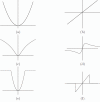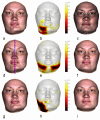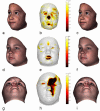Dysmorphometrics: the modelling of morphological abnormalities
- PMID: 22309623
- PMCID: PMC3297492
- DOI: 10.1186/1742-4682-9-5
Dysmorphometrics: the modelling of morphological abnormalities
Abstract
Background: The study of typical morphological variations using quantitative, morphometric descriptors has always interested biologists in general. However, unusual examples of form, such as abnormalities are often encountered in biomedical sciences. Despite the long history of morphometrics, the means to identify and quantify such unusual form differences remains limited.
Methods: A theoretical concept, called dysmorphometrics, is introduced augmenting current geometric morphometrics with a focus on identifying and modelling form abnormalities. Dysmorphometrics applies the paradigm of detecting form differences as outliers compared to an appropriate norm. To achieve this, the likelihood formulation of landmark superimpositions is extended with outlier processes explicitly introducing a latent variable coding for abnormalities. A tractable solution to this augmented superimposition problem is obtained using Expectation-Maximization. The topography of detected abnormalities is encoded in a dysmorphogram.
Results: We demonstrate the use of dysmorphometrics to measure abrupt changes in time, asymmetry and discordancy in a set of human faces presenting with facial abnormalities.
Conclusion: The results clearly illustrate the unique power to reveal unusual form differences given only normative data with clear applications in both biomedical practice & research.
Figures








References
-
- Blackith R, Reyment R. Multivariate Morphometrics. New York: Academic Press; 1971.
-
- Penrose L. Distance, size and shape. Annals of Eugenics. 1954;18:337–343. - PubMed
-
- Lestrel P. Morphometrics for the life sciences Volume 7 of Recent advances in human biology. World Scientific Publishing Co. Pte. Ltd; 2000.
-
- Zelditch M, Swiderski D, Sheets H, Fink W. Geometric morphometrics for biologists: A primer. New York and London: Elsevier Academic Press; 2004.
Publication types
MeSH terms
LinkOut - more resources
Full Text Sources

